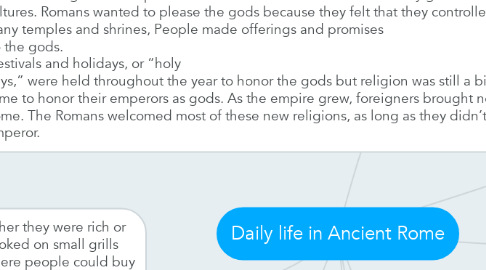Daily life in Ancient Rome
by Jack K

1. Section 4 Religion was important to the Romans the Romans had many gods and adopted some off other cultures. Romans wanted to please the gods because they felt that they controlled their lives. At Rome's many temples and shrines, People made offerings and promises to the gods. Festivals and holidays, or “holy days,” were held throughout the year to honor the gods but religion was still a big part. In time, the Romans came to honor their emperors as gods. As the empire grew, foreigners brought new forms of worship to Rome. The Romans welcomed most of these new religions, as long as they didn’t encourage disloyalty to the emperor.
2. Section 5 Family life in Rome was ruled by the paterfamilias Roman men were supposed to provide for there family. The woman In Rome ran their households. Between the ages of 14 through 18 a Roman celebrated by becoming a man
3. Section 6 What Romans cooked and ate depended on whether they were rich or poor. Only the rich had kitchens in their homes. The poor cooked on small grills and depended on “fast-food” places called thermopolia where people could buy hot and cold foods that were ready to eat. Even the rich often bought their daytime meals at thermopolia because the service was fast and convenient. The main foods in ancient Rome were bread, beans, spices, a few vegetables, cheeses, and meats. Favorite drinks included plain water and hot water with herbs and honey.
4. Section 7 Wealthy Romans lived in grand houses made of marble and stone. Beyond the atrium, there were many rooms for the family and guests. The fanciest room was the dining room. Many poor people lived in tiny apartments. The apartments the poor people lived in were cramped, noisy, and dirty.
5. Section 8 Many poor children in Rome were sent to work instead of to school. They learned trades, such as leatherworking and metalworking, to help earn money for their families. In wealthier families, boys and girls were tutored by their fathers, or often by slaves, until they were about six years old. Then boys went off to school. Classes were held in public buildings and private homes. Many of the tutors were educated Greek slaves. Roman boys learned Latin, Greek, math, science, literature, music, and public speaking. They typically became soldiers, doctors, politicians, or lawyers. Girls might become dentists, real estate agents, or tutors.
6. Section 2 Rome was full of beautiful temples, stately places, and flowing gardens yet most of the people lived in tiny apartments crammed into little narrow dirty streets. Nearly one million people lived in the empire’s capital city. To keep the poor from turning into an angry mob, Roman emperors gave away food and provided entertainment including gladiator contests and chariot races.
7. Section 3 In the empire the ultimate source of the law was the emperor. But the senate still decided to meet and had high social status. In Rome the laws were strict but crime was still common. Any roman could accuse someone of a crime and they would go to jury to have a trial.
8. Section 9 The rich enjoyed plays in theaters and musical performances in one another’s homes. Both rich and poor often relaxed at Rome’s public baths. A favorite gathering place was the Circus Maximus, a huge racetrack with room for 200,000 spectators.
9. Section 10 Wealthy Romans often owned country estates with large homes, called villas. The empire’s farms provided much of the food for Rome and other cities. They produced grain for bread, grapes for wine, and olives for oil. Slaves did much of the actual work of farming. Overseers, or supervisors, kept a close eye on the slaves and often treated them cruelly. Many people in the countryside were not slaves, but their lives were hard.


